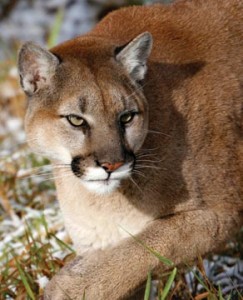 Leaders everywhere demand respect and attention wherever they roam. When translated into a natural setting, the leaders of our forests and mountains demand the same respect. They usually receive it, particularly the mountain lion. The leaders of the forest have much to share with us on adaptations leading to success.
Leaders everywhere demand respect and attention wherever they roam. When translated into a natural setting, the leaders of our forests and mountains demand the same respect. They usually receive it, particularly the mountain lion. The leaders of the forest have much to share with us on adaptations leading to success.
The animals that are the biggest and strongest are viewed as the leaders in our natural environment. When we think about leaders in nature, animals that are biggest, fastest and the best hunters spring forward as clear-cut front runners. Of our native species here in Colorado the animal that possesses these characteristics is the Mountain Lion (felis concolor). The largest and most majestic of the cat species in Colorado, the mountain lion demands the respect of all other species.
The size of a mountain lion is impressive by itself. Adult males are larger than females and can be as big as 200 pounds with a body length of 8 feet or longer and a distinctive tail measuring up to 2.5 feet. Those of us lucky enough to see a lion in nature can draw the true appreciation of size and beauty. Viewing this beautiful cat proves tricky since they are a mostly nocturnal creature.
As with any leader, there are those people (or animals in the mountain lions case), that keep them in power. The mountain lion’s support comes from the species that keep it well fed. A savvy hunter such as the mountain lion has a long list of prey including: deer, elk, mice, ground squirrels, beavers, lagomorphs, porcupines, wild hogs, raccoons, armadillos and domestic livestock. With such a diverse food supply, it’s easy to see how these cats have been able to stay in a position of power.
Their hunting adaptation has led mountain lions to expand to virtually all habitats imaginable. They’ve been spotted from the Yukon Territory of Canada to Tierra del Fuego in South America. These diverse habitats are a large reason why there are so many names for the same species. The names mountain lion, cougar, puma and catamount all refer to the same animal. The term puma came from an Incan word and the name cougar originated in the jungles of Brazil.
With all this power in the natural world, the mountain lion has little to fear in the way of predators. In fact, humans have the greatest impact on lion populations. Historically here in Colorado the mountain lion was a bounty species - dead lions could be turned in for a cash reward as recently as 1965. Since then, populations have stabilized but still face the risk of being eliminated by humans. As with any wild animal, lions should always be viewed with caution and reverence when encountered in the wild. If you are lucky enough to spot one, sit back, enjoy and know that you’re seeing one of the best established leaders of the wild world.
Author Travis Long is a winter naturalist for Walking Mountains Science Center. When not teaching about the wonders of nature he enjoys exploring it on a set of skis or snowshoes. If you are interested in seeing and learning more about our local animals, please join a Walking Mountains naturalist on a free nature tour departing from the Nature Discovery Center on top of Vail Mountain daily in summertime at 11am and 2pm.









